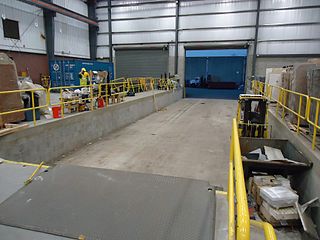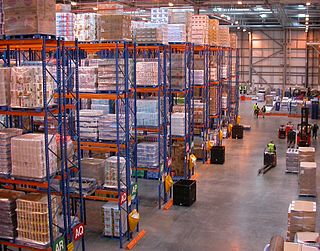Related Research Articles

In commerce, supply chain management (SCM) deals with a system of procurement, operations management, logistics and marketing channels, through which raw materials can be developed into finished products and delivered to their end customers. A more narrow definition of supply chain management is the "design, planning, execution, control, and monitoring of supply chain activities with the objective of creating net value, building a competitive infrastructure, leveraging worldwide logistics, synchronising supply with demand and measuring performance globally". This can include the movement and storage of raw materials, work-in-process inventory, finished goods, and end to end order fulfilment from the point of origin to the point of consumption. Interconnected, interrelated or interlinked networks, channels and node businesses combine in the provision of products and services required by end customers in a supply chain.

Logistics is the part of supply chain management that deals with the efficient forward and reverse flow of goods, services, and related information from the point of origin to the point of consumption according to the needs of customers. Logistics management is a component that holds the supply chain together. The resources managed in logistics may include tangible goods such as materials, equipment, and supplies, as well as food and other consumable items.

Inventory or stock refers to the goods and materials that a business holds for the ultimate goal of resale, production or utilisation.

Distribution is the process of making a product or service available for the consumer or business user who needs it, and a distributor is a business involved in the distribution stage of the value chain. Distribution can be done directly by the producer or service provider or by using indirect channels with distributors or intermediaries. Distribution is one of the four elements of the marketing mix: the other three elements being product, pricing, and promotion.

Logistics automation is the application of computer software or automated machinery to logistics operations in order to improve its efficiency. Typically this refers to operations within a warehouse or distribution center, with broader tasks undertaken by supply chain engineering systems and enterprise resource planning systems.

A warehouse is a building for storing goods. Warehouses are used by manufacturers, importers, exporters, wholesalers, transport businesses, customs, etc. They are usually large plain buildings in industrial parks on the outskirts of cities, towns, or villages.
Vendor-managed inventory (VMI) is an inventory management practice in which a supplier of goods, usually the manufacturer, is responsible for optimizing the inventory held by a distributor.

Cross-docking is a logistical practice of Just-In-Time Scheduling where materials are delivered directly from a manufacturer or a mode of transportation to a customer or another mode of transportation. Cross-docking often aims to minimize overheads related to storing goods between shipments or while awaiting a customer's order. This may be done to change the type of conveyance, to sort material intended for different destinations, or to combine material from different origins into transport vehicles with the same or similar destinations.

A distribution center for a set of products is a warehouse or other specialized building, often with refrigeration or air conditioning, which is stocked with products (goods) to be redistributed to retailers, to wholesalers, or directly to consumers. A distribution center is a principal part, the order processing element, of the entire order fulfillment process. Distribution centers are usually thought of as being demand driven. A distribution center can also be called a warehouse, a DC, a fulfillment center, a cross-dock facility, a bulk break center, and a package handling center. The name by which the distribution center is known is commonly based on the purpose of the operation. For example, a "retail distribution center" normally distributes goods to retail stores, an "order fulfillment center" commonly distributes goods directly to consumers, and a cross-dock facility stores little or no product but distributes goods to other destinations.

Reverse logistics encompasses all operations related to the upstream movement of products and materials. It is "the process of moving goods from their typical final destination for the purpose of capturing value, or proper disposal. Remanufacturing and refurbishing activities also may be included in the definition of reverse logistics." Growing green concerns and advancement of green supply chain management concepts and practices make it all the more relevant. The number of publications on the topic of reverse logistics have increased significantly over the past two decades. The first use of the term "reverse logistics" in a publication was by James R. Stock in a White Paper titled "Reverse Logistics," published by the Council of Logistics Management in 1992. The concept was further refined in subsequent publications by Stock (1998) in another Council of Logistics Management book, titled Development and Implementation of Reverse Logistics Programs, and by Rogers and Tibben-Lembke (1999) in a book published by the Reverse Logistics Association titled Going Backwards: Reverse Logistics Trends and Practices. The reverse logistics process includes the management and the sale of surplus as well as returned equipment and machines from the hardware leasing business. Normally, logistics deal with events that bring the product towards the customer. In the case of reverse logistics, the resource goes at least one step back in the supply chain. For instance, goods move from the customer to the distributor or to the manufacturer.
Consignment is a process whereby a person gives permission to another party to take care of their property and retains full ownership of the property until the item is sold to the final buyer. It is generally done during auctions, shipping, goods transfer, or putting something up for sale in a consignment store. The owner of the goods pays the third-party a portion of the sale for facilitating the sale. Consignors maintain the rights to their property until the item is sold or abandoned. Many consignment shops and online consignment platforms have a set time limit at which an item's availability for sale expires. Within the time of contract, reductions of the price are common to promote the sale of the item, but vary by the type of item sold.

In accounting, the inventory turnover is a measure of the number of times inventory is sold or used in a time period such as a year. It is calculated to see if a business has an excessive inventory in comparison to its sales level. The equation for inventory turnover equals the cost of goods sold divided by the average inventory. Inventory turnover is also known as inventory turns, merchandise turnover, stockturn, stock turns, turns, and stock turnover.

Once the strategic plan is in place, retail managers turn to the more managerial aspects of planning. A retail mix is devised for the purpose of coordinating day-to-day tactical decisions. The retail marketing mix typically consists of six broad decision layers including product decisions, place decisions, promotion, price, personnel and presentation. The retail mix is loosely based on the marketing mix, but has been expanded and modified in line with the unique needs of the retail context. A number of scholars have argued for an expanded marketing, mix with the inclusion of two new Ps, namely, Personnel and Presentation since these contribute to the customer's unique retail experience and are the principal basis for retail differentiation. Yet other scholars argue that the Retail Format should be included. The modified retail marketing mix that is most commonly cited in textbooks is often called the 6 Ps of retailing.

In accounting, shrinkage or shrink occurs when a retailer has fewer items in stock than were expected by the inventory list. This can be caused by clerical error, or from goods being damaged, lost, or stolen between the point of manufacture and the point of sale. High shrinkage can adversely affect a retailer's profit.

A stockout, or out-of-stock (OOS) event is an event that causes inventory to be exhausted. While out-of-stocks can occur along the entire supply chain, the most visible kind are retail out-of-stocks in the fast-moving consumer goods industry. Stockouts are the opposite of overstocks, where too much inventory is retained. A backorder is an order placed for an item which is out-of-stock and awaiting fulfillment.
Field inventory management, commonly known as inventory management, is the task of understanding the stock mix of a company and the handling of the different demands placed on that stock. The demands are influenced by both external and internal factors and are balanced by the creation of purchase order requests to keep supplies at a reasonable or prescribed level. Inventory management is important for every other business enterprise.
Stock clearance is an activity by a company where ownership of products and materials moves on to another legal entity. These products and materials in stock clearance will not form the basis of a company's key activities. As such, they are often end-of-line, surplus, returned, or bankrupt.
Work in process or work-in-process, (WIP), work in progress (WIP), goods in process, or in-process inventory refers to a company's partially finished goods waiting for completion and eventual sale, or the value of these items. The term is used in supply chain management, and WIP is a key input for calculating inventory on a company's balance sheet. In lean thinking, inappropriate processing or excessive processing of goods or work in process, "doing more than is necessary", is seen as one of the seven wastes which do not add value to a product.
In marketing, carrying cost, carrying cost of inventory or holding cost refers to the total cost of holding inventory. This includes warehousing costs such as rent, utilities and salaries, financial costs such as opportunity cost, and inventory costs related to perishability, shrinkage, and insurance. Carrying cost also includes the opportunity cost of reduced responsiveness to customers' changing requirements, slowed introduction of improved items, and the inventory's value and direct expenses, since that money could be used for other purposes. When there are no transaction costs for shipment, carrying costs are minimized when no excess inventory is held at all, as in a just-in-time production system.
Inventory management software is a software system for tracking inventory levels, orders, sales and deliveries. It can also be used in the manufacturing industry to create a work order, bill of materials and other production-related documents. Companies use inventory management software to avoid product overstock and outages. It is a tool for organizing inventory data that before was generally stored in hard-copy form or in spreadsheets.
References
- 1 2 3 Crandall, R. E. and Crandall, W. R., Managing Excess Inventories: A Life-Cycle Approach, in The Academy of Management Executive (1993-2005), Vol. 17, No. 3 (August 2003), pp. 99-113, accessed 18 July 2023
- ↑ Rosenfield, D. B., Disposal of Excess Inventory in Operations Research , May-June 1989, Vol. 37, No. 3, pp. 404-409, quoted in Crandall and Crandall, accessed 18 July 2023
- ↑ "Reorganisation von Bauprozessen" (PDF). 2004-07-22. Retrieved 2013-01-22.
- ↑ McBride, D., The 7 Wastes in Manufacturing, EMS Consulting Group, published 29 August 2003, accessed 18 July 2023
- ↑ "Buyers of Overstock Inventory". merchandiseusa.com. Retrieved 2023-01-06.